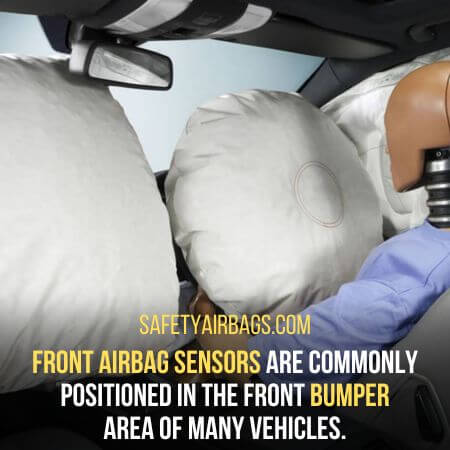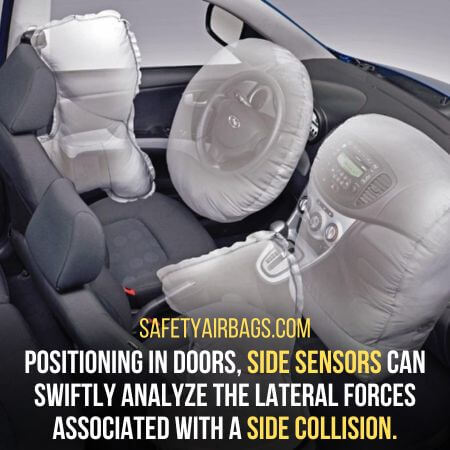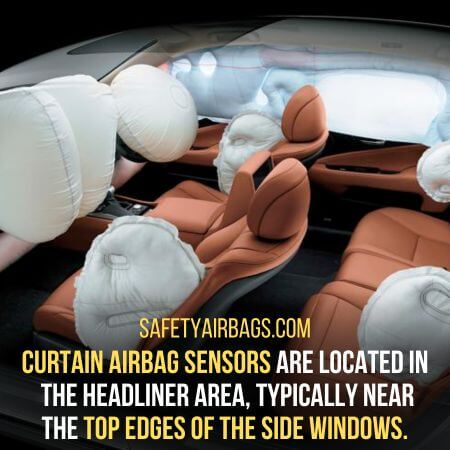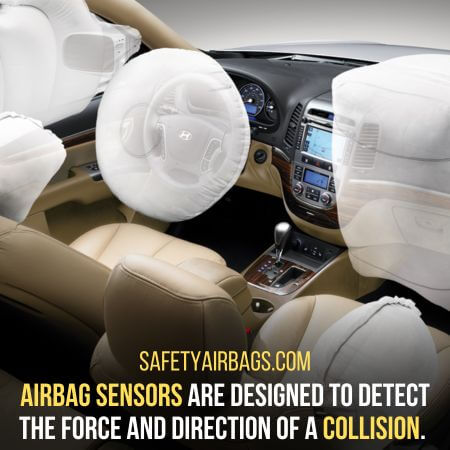Where are the airbag sensors located? Airbag sensors are typically located in various strategic positions throughout a vehicle.
Some common areas include the front bumper, front grille, engine compartment, side doors, pillars (A-pillar, B-pillar, C-pillar), seats, headliner area, rear pillars, etc.
Where Are The Airbag Sensors Located? – Front Airbag Sensors
Front airbag sensors are electronic devices designed to detect sudden deceleration or changes in vehicle velocity that indicate a collision.
They are also known as crash sensors or impact sensors. They are responsible for detecting the severity of the impact.
They send signals to the airbag control unit (ACU) to initiate airbag deployment.
The primary locations of front airbag sensors are
1. Front bumper area:
Front airbag sensors are commonly positioned in the front bumper area of many vehicles.

This strategic placement allows the sensors to effectively detect impacts at the front of the vehicle, including head-on collisions or collisions with other objects.
2. Front grille area:
In some vehicles, front airbag sensors are near the front grille.
This location ensures the sensors have a clear line of sight and can accurately detect frontal impacts.
This way, they can provide timely activation of the front airbags for occupant protection.
3. Engine compartment:
Front airbag sensors may also be located within the engine compartment, typically mounted on the front frame rails or firewall.
Placing the sensors in this area allows them to be near critical impact zones.
This ensures efficient frontal collision detection and facilitates rapid front airbags deployment to minimize occupant injury.
Function and operation of front airbag sensors
Front airbag sensors operate using various technologies such as accelerometers, gyroscopes, or pressure sensors.
These sensors continuously monitor the vehicle’s acceleration and deceleration rates.
When a collision occurs, sudden deceleration or changes in velocity trigger the front airbag sensors to send signals to the ACU.
Factors influencing front airbag sensor deployment:
Several factors influence the deployment of front airbags by the airbag control unit:
1. The severity of impact:
The front airbag sensors measure the force and magnitude of the impact.
The ACU uses this information to determine if airbag deployment is necessary and, if so, at what intensity.
2. Collision angle:
The collision’s angle affects the decision to deploy front airbags.
Certain collision angles may not require airbag deployment, while others may warrant deployment to protect occupants effectively.
3. Occupant position and weight:
The presence and position of occupants and their weight are crucial factors in determining front airbag deployment.
Advanced systems can measure occupant weight using seat sensors or other weight-detection technologies.
They optimize airbag deployment and minimize the risk of injury to occupants.
4. Seatbelt usage:
The front airbag system works in conjunction with seatbelt systems.
The ACU considers whether the occupants wear seatbelts to decide on the appropriate airbag deployment strategy.
5. Vehicle speed:
Front airbag sensors may also consider the vehicle’s speed at the time of impact.
Higher speeds may trigger more forceful airbag deployments to protect occupants in severe collisions.
Side Airbag Sensors
Side airbag sensors are electronic components that detect side-impact collisions and activate the corresponding side airbags.
These sensors enhance occupant safety during lateral impacts, providing additional protection to vehicle occupants.
Typical locations of side airbag sensors are
1. Side doors:
Side airbag sensors are commonly integrated into the side doors of many vehicles.
This placement allows the sensors to detect impacts occurring near the doors accurately.

Positioning in the doors, these sensors can swiftly analyze the lateral forces associated with a side collision.
They can trigger the deployment of side airbags to protect the occupants effectively.
2. Pillars (A-pillar, B-pillar, C-pillar):
Vehicle pillars, including the A-pillar, B-pillar, and C-pillar, often house side airbag sensors.
These sensors are strategically located within the pillars to detect impacts along the vehicle’s sides.
By monitoring the forces exerted on the pillars during a side collision, these sensors facilitate the timely activation of the side airbags.
This way, they can reduce the risk of injury to the occupants.
3. Seats:
Some vehicles incorporate side airbag sensors within the seats. These sensors are specifically designed to detect lateral impacts, such as a T-bone collision.
By being located within the seats, these sensors can quickly assess the severity of the impact and activate the side airbags to protect the occupants’ upper bodies.
This placement ensures a rapid response and enhances occupant safety during a side collision.
Role of side airbag sensors in occupant protection:
The primary role of side airbag sensors is to enhance occupant protection during side-impact collisions.
When a side impact occurs, these sensors detect the rapid deceleration and lateral forces associated with the collision.
The information gathered by the sensors is sent to the airbag control unit (ACU).
It then deploys the side airbags to provide a cushioning effect and reduce the risk of injury to occupants.
Factors influencing side airbag sensor activation:
Several factors influence the activation of side airbag sensors:
1. Collision force:
The magnitude of the lateral impact force plays a crucial role in determining whether the side airbag sensors will activate the side airbags.
Higher forces indicate a more severe collision and may prompt the activation of the side airbags.
2. Collision location:
The location of the impact along the vehicle’s side can influence side airbag sensor activation.
The sensors are designed to detect impacts in specific areas, such as the side doors or pillars, and respond accordingly.
3. Occupant position and proximity:
The position and proximity of the vehicle occupants to the side airbag sensors are important factors.
The sensors consider the presence of occupants near the impact area to ensure the timely and appropriate deployment of the side airbags.
Curtain airbag deployment:
In some cases, side airbag sensors may also activate curtain airbags.
These sensors detect the severity of the impact and, if necessary, trigger the deployment of curtain airbags.
This way, they can provide additional protection for the occupants’ heads during a side collision.
Curtain Airbag Sensors
Curtain airbag sensors are sided curtain airbag sensors or roof-mounted airbag sensors.
They are designed to detect side-impact collisions and trigger the deployment of curtain airbags.

These sensors work with other airbag sensors to provide enhanced occupant protection during side collisions, particularly for the head and upper body.
Common locations of curtain airbag sensors are
1. Headliner area:
Curtain airbag sensors are often located in the headliner area, typically near the top edges of the side windows.
This placement ensures that the sensors have a clear view of the side impact and can quickly initiate the deployment of the curtain airbags.
2. Rear pillars:
Some vehicles have curtain airbag sensors in the rear pillars, such as the B-pillar or C-pillar.
These sensors monitor the impact force and lateral acceleration to determine the need for deploying the curtain airbags.
Knee Airbag Sensors
Knee airbag sensors are designed to detect the likelihood of knee injuries during a collision and activate the knee airbags accordingly.
Knee airbags are designed to protect the lower body, including the knees and legs, by reducing the risk of impact with hard surfaces in the vehicle’s cabin.
Primary locations of knee airbag sensors are:
1. Instrument panel:
Knee airbag sensors are commonly located in the instrument panel, often positioned below the steering column.
This placement allows the sensors to detect rapid deceleration or deformation of the instrument panel, indicating the need for knee airbag deployment.
2. Lower dashboard area:
Some vehicles may have knee airbag sensors near the driver and passenger’s knees in the lower dashboard area.
These sensors monitor the forces and impacts in this region to determine if knee airbag deployment is necessary.
Importance of airbag sensors in vehicle safety
Airbag sensors are designed to detect the force and direction of a collision.
They accurately measure factors such as acceleration, deceleration, and impact angles to assess the severity of the crash.

This information helps determine the appropriate airbags to deploy and the timing of their deployment.
1. Occupant Protection:
By deploying airbags promptly, airbag sensors help minimize the risk of severe injuries to vehicle occupants.
They assist in mitigating the impact of a crash by creating a cushioning effect between occupants and the vehicle’s hard surfaces.
This protection is particularly crucial during high-speed collisions or accidents involving multiple impacts.
2. Adaptive Response:
Modern airbag sensor systems are designed to adapt their response based on various factors.
These factors include the weight, position, and presence of occupants, allowing for optimized airbag deployment.
This adaptability enhances occupant safety and reduces the risk of unnecessary airbag deployment when it is not needed.
3. Secondary Collision Protection:
Airbag sensors also play a role in protecting occupants during secondary collisions.
After the initial impact, the sensors continue to monitor the vehicle’s movements and can trigger additional airbag deployments if necessary.
This feature ensures ongoing protection in situations such as rollovers or multiple impacts.
Conclusion:
Airbag sensors are integral components of vehicle safety systems.
Sensors ensure the timely and effective deployment of airbags, minimizing the risk of injuries to vehicle occupants.
By continuously monitoring and responding to various factors, airbag sensors significantly enhance occupant safety and reduce the severity of injuries in automobile accidents.
